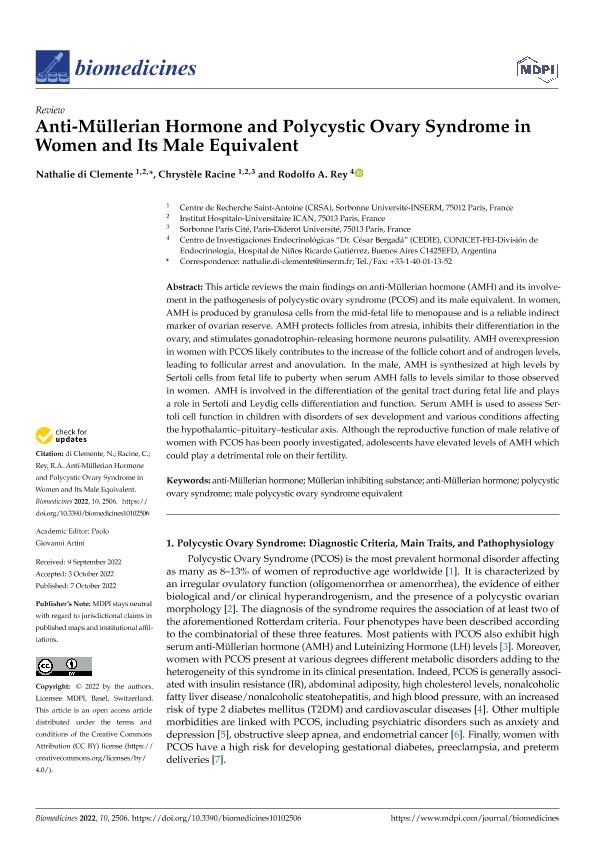Mostrar el registro sencillo del ítem
dc.contributor.author
di Clemente, Nathalie
dc.contributor.author
Racine, Chrystèle
dc.contributor.author
Rey, Rodolfo Alberto

dc.date.available
2023-08-29T17:58:13Z
dc.date.issued
2022-10
dc.identifier.citation
di Clemente, Nathalie; Racine, Chrystèle; Rey, Rodolfo Alberto; Anti-Müllerian Hormone and Polycystic Ovary Syndrome in Women and Its Male Equivalent; MDPI; Biomedicines; 10; 10; 10-2022; 1-12
dc.identifier.issn
2227-9059
dc.identifier.uri
http://hdl.handle.net/11336/209805
dc.description.abstract
This article reviews the main findings on anti-Müllerian hormone (AMH) and its involvement in the pathogenesis of polycystic ovary syndrome (PCOS) and its male equivalent. In women, AMH is produced by granulosa cells from the mid-fetal life to menopause and is a reliable indirect marker of ovarian reserve. AMH protects follicles from atresia, inhibits their differentiation in the ovary, and stimulates gonadotrophin-releasing hormone neurons pulsatility. AMH overexpression in women with PCOS likely contributes to the increase of the follicle cohort and of androgen levels, leading to follicular arrest and anovulation. In the male, AMH is synthesized at high levels by Sertoli cells from fetal life to puberty when serum AMH falls to levels similar to those observed in women. AMH is involved in the differentiation of the genital tract during fetal life and plays a role in Sertoli and Leydig cells differentiation and function. Serum AMH is used to assess Sertoli cell function in children with disorders of sex development and various conditions affecting the hypothalamic–pituitary–testicular axis. Although the reproductive function of male relative of women with PCOS has been poorly investigated, adolescents have elevated levels of AMH which could play a detrimental role on their fertility.
dc.format
application/pdf
dc.language.iso
eng
dc.publisher
MDPI
dc.rights
info:eu-repo/semantics/openAccess
dc.rights.uri
https://creativecommons.org/licenses/by/2.5/ar/
dc.subject
ANTI-MÜLLERIAN HORMONE
dc.subject
ANTI-MÜLLERIAN HORMONE
dc.subject
MALE POLYCYSTIC OVARY SYNDROME EQUIVALENT
dc.subject
MÜLLERIAN INHIBITING SUBSTANCE
dc.subject
POLYCYSTIC OVARY SYNDROME
dc.subject.classification
Endocrinología y Metabolismo

dc.subject.classification
Medicina Clínica

dc.subject.classification
CIENCIAS MÉDICAS Y DE LA SALUD

dc.title
Anti-Müllerian Hormone and Polycystic Ovary Syndrome in Women and Its Male Equivalent
dc.type
info:eu-repo/semantics/article
dc.type
info:ar-repo/semantics/artículo
dc.type
info:eu-repo/semantics/publishedVersion
dc.date.updated
2023-07-07T23:02:02Z
dc.journal.volume
10
dc.journal.number
10
dc.journal.pagination
1-12
dc.journal.pais
Suiza

dc.description.fil
Fil: di Clemente, Nathalie. Inserm; Francia
dc.description.fil
Fil: Racine, Chrystèle. Inserm; Francia
dc.description.fil
Fil: Rey, Rodolfo Alberto. Consejo Nacional de Investigaciones Científicas y Técnicas. Oficina de Coordinación Administrativa Parque Centenario. Centro de Investigaciones Endocrinológicas "Dr. César Bergada". Gobierno de la Ciudad de Buenos Aires. Centro de Investigaciones Endocrinológicas "Dr. César Bergada". Fundación de Endocrinología Infantil. Centro de Investigaciones Endocrinológicas "Dr. César Bergada"; Argentina
dc.journal.title
Biomedicines
dc.relation.alternativeid
info:eu-repo/semantics/altIdentifier/url/https://www.mdpi.com/2227-9059/10/10/2506
dc.relation.alternativeid
info:eu-repo/semantics/altIdentifier/doi/http://dx.doi.org/10.3390/biomedicines10102506
Archivos asociados
